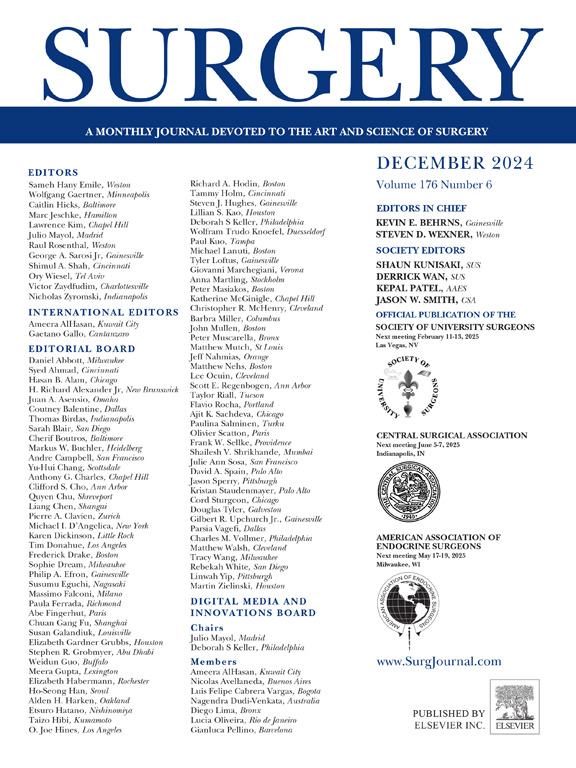Young-derived M2-like macrophages ameliorate hindlimb ischemia injury by promoting neovascularization in aged mice
IF 2.7
2区 医学
Q1 SURGERY
引用次数: 0
Abstract
Background
Peripheral artery disease, an age-related ischemic disease, primarily affects the elderly. Cell therapy is a promising treatment for peripheral artery disease. This study aims to investigate the effects of macrophages derived from young mice on neovascularization and recovery in a hindlimb ischemia model of aged mice.
Methods
Monocytes were isolated from the bone marrow of young mice and cultured in vitro to generate bone marrow–derived macrophages. After polarization, young-derived M2-like bone marrow–derived macrophages were obtained. Aged mice were divided into 3 groups: saline group, young-derived nonpolarized bone marrow–derived macrophages group, and young-derived M2-like bone marrow–derived macrophages group. Hindlimb ischemia was induced in aged mice via femoral artery ligation. Three days after surgery, saline, young-derived nonpolarized bone marrow–derived macrophages, or young-derived M2-like bone marrow–derived macrophages were intramuscularly injected into the ischemic hindlimb. Doppler imaging, ischemia and mobility scores, and histological analysis were used to assess blood flow, functional recovery, and tissue repair. Neovascularization was further evaluated using micro–computed tomography and immunofluorescence staining.
Results
Compared with the saline group, aged mice in the young-derived M2-like bone marrow–derived macrophages group exhibited notable blood flow recovery, along with corresponding improvements in tissue and functional recovery. In addition, in terms of neovascularization, the young-derived M2-like bone marrow–derived macrophages group demonstrated a richer vascular bed, with significant increases in both arteriogenesis and angiogenesis, as well as enhanced endothelial cell function.
Conclusion
M2-like macrophages derived from young mice enhance neovascularization of aged mice with ischemia, leading to improved blood perfusion and tissue functional recovery. This suggests that macrophages represent a promising new therapeutic strategy for peripheral artery disease in the elderly.

年轻来源的m2样巨噬细胞通过促进新生血管来改善老年小鼠后肢缺血损伤
外周动脉疾病是一种与年龄相关的缺血性疾病,主要影响老年人。细胞疗法是外周动脉疾病的一种很有前途的治疗方法。本研究旨在探讨幼年小鼠巨噬细胞对老年小鼠后肢缺血模型中新生血管和恢复的影响。方法从幼鼠骨髓中分离单核细胞,体外培养生成骨髓源性巨噬细胞。极化后,获得年轻来源的骨髓来源的m2样巨噬细胞。老龄小鼠分为3组:生理盐水组、年轻源性非极化骨髓源性巨噬细胞组、年轻源性m2样骨髓源性巨噬细胞组。采用股动脉结扎法诱导老年小鼠后肢缺血。术后3天,将生理盐水、年轻源性非极化骨髓源性巨噬细胞或年轻源性m2样骨髓源性巨噬细胞肌内注射到缺血后肢。多普勒成像、缺血和运动能力评分以及组织学分析用于评估血流、功能恢复和组织修复。用微计算机断层扫描和免疫荧光染色进一步评估新生血管。结果与生理盐水组相比,年轻源性m2样骨髓源性巨噬细胞组老龄小鼠血流明显恢复,组织和功能恢复也相应改善。此外,在新生血管方面,年轻源性m2样骨髓源性巨噬细胞组血管床更丰富,动脉生成和血管生成均显著增加,内皮细胞功能增强。结论年轻小鼠来源的m2样巨噬细胞可促进老年缺血小鼠的新生血管形成,促进血液灌注和组织功能恢复。这表明巨噬细胞是治疗老年人外周动脉疾病的一种有前景的新策略。
本文章由计算机程序翻译,如有差异,请以英文原文为准。
求助全文
约1分钟内获得全文
求助全文
来源期刊

Surgery
医学-外科
CiteScore
5.40
自引率
5.30%
发文量
687
审稿时长
64 days
期刊介绍:
For 66 years, Surgery has published practical, authoritative information about procedures, clinical advances, and major trends shaping general surgery. Each issue features original scientific contributions and clinical reports. Peer-reviewed articles cover topics in oncology, trauma, gastrointestinal, vascular, and transplantation surgery. The journal also publishes papers from the meetings of its sponsoring societies, the Society of University Surgeons, the Central Surgical Association, and the American Association of Endocrine Surgeons.
 求助内容:
求助内容: 应助结果提醒方式:
应助结果提醒方式:


